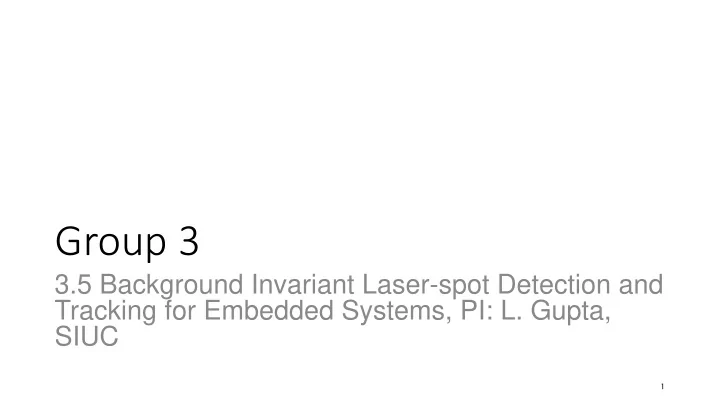

Group 3 3.5 Background Invariant Laser-spot Detection and Tracking for Embedded Systems, PI: L. Gupta, SIUC 1
Background Invariant Laser-spot Detection and Tracking for Embedded Systems PI: Lalit Gupta, Ph.D Professor, ECE, SIUC Students: Yang Bai, Ph.D student, SIUC Ahmed Fadhil, Ph.D, SIUC Raghuveer Kanneganti, Ph.D student, SIUC Matthew M. Wilding & Steven E. Koenck Rockwell Collins CONFIDENTIAL Center for Embedded Systems | An NSF Industry/University Cooperative Research Center
Project Overview and Description • Develop a methodology to: • Accurately detect laser-spots in low-resolution images • Track the laser-spot in varying background and illumination conditions. • Applications: • Smart Munitions: Targeting, Guiding, Counter- measure • Robotics: Navigation http://www.popularmechanics.com/technology/military/research/8-laser-weapon-systems 3
• Detection Approach • Filtering • Segmentation • Feature extraction – shape, color, intensity • Classification • Tracking • Background subtraction, Kalman filter, Particle filter Initial Focus: Detect laser-spots in static and simple backgrounds. Subsequent Efforts: Dynamic, complex, and noisy backgrounds. Final goal: Embed the detection and tracking strategy into a multi- core processing architecture 4
Project Status • Progress to date (new project) – Acquired laser spots in varying backgrounds – Developed Intensity based segmentation – Implemented Kalman Filter 5
Project Tasks/ Deliverables Description Date Status 1 Study characteristics of laser-spots in varying backgrounds Ongoing 2 Develop laser-spot detection algorithms Ongoing 3 Develop laser-tracking algorithms Ongoing 4 Test detection and tracking algorithms in simple backgrounds Ongoing 5 Test detection and tracking algorithms in complex backgrounds including missing objects in frames 6 Embed the detection and tracking strategy into a multi-core processing architecture 6
Executive Summary • Develop method to • Detect and track laser-spots • Applications • Military • Robotics http://www.fastcompany.com/welcome.html?destination=http://www.fastcompa • New applications ny.com/1823017/darpa-unveils-drone-slaying-war-laser Detection Scene Feature Acquisition Preprocessing Segmentation Extraction Kalman Filter Laser-spot location Tracking 7
Recommend
More recommend